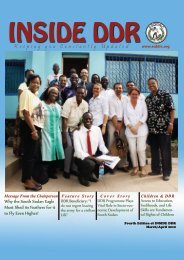Examining Enterprise Capacity - SSDDRC
Examining Enterprise Capacity - SSDDRC
Examining Enterprise Capacity - SSDDRC
Create successful ePaper yourself
Turn your PDF publications into a flip-book with our unique Google optimized e-Paper software.
<strong>Enterprise</strong> Activity<br />
Many of the IDPs expressed their desire to participate in enterprise activities. There exists a small<br />
but active market at Obel, where a variety of goods and services are sold, including fish, meat,<br />
cigarettes, wood and kitchen utensils. Women are active in the Obel market, selling wood and<br />
grasses that they have collected and retail items brought in from outside markets. Women are also<br />
responsible for the production of food items including coffee and tea, based on stereotypical<br />
gendered division of labor within these communities.<br />
Some IDPs at Obel stated that they are ready for entrepreneurship activity and training in enterprise<br />
related investment, planning and management. Brick making was suggested as a possible enterprise<br />
opportunity, which would use the abundant supply of cattle dung and would address the construction<br />
needs of the community. Irrigation systems for farming would improve productivity of farmers,<br />
possibly allowing more residents to participate in small-scale market-focused agriculture.<br />
Microfinance, banks and revolving funds were discussed by community members, but access to<br />
these are currently non-existent at Obel. It was mentioned that there were past loan schemes with<br />
fishermen, yet these were not successful because the loans were defaulted.<br />
Aid and Assistance<br />
Health services and education were<br />
stated by the focus groups as the top<br />
Aid and Assistance Required % of Community<br />
assistance required. This reflected the Hospitals/Health Services 34%<br />
desire in the community for more<br />
education opportunities beyond the<br />
More Schools/Education 30%<br />
primary education already provided.<br />
Health requirements reflect that the<br />
community is unable to access existing<br />
services at the town of Malakal, most<br />
likely due to distance and lack of funds<br />
Access to Transportation<br />
Agriculture Tools and Equipment<br />
28%<br />
8%<br />
and identification. Access to transportation between Malakal and Obel would improve work<br />
opportunities and market access for the IDPs.<br />
The IDPs stated that currently there are no NGOs providing training, services or safe drinking water to<br />
the IDPs at Obel camp. The World Food Programme (WFP) delivers food twice annually at irregular<br />
intervals. The IDPs at Obel are concerned that the food aid will decrease, since the announcement<br />
that the WFP will cut food aid and shift services from IDPs in camps to returnees at their places of<br />
origin.<br />
Constraints<br />
Interestingly, personal safety was rated Livelihood-related Constraints % of Community<br />
extremely high as a concern of the IDPs<br />
during the focus groups. This could<br />
Personal Safety 50%<br />
reflect the dangers in the area for women Shortage of Tools (boats, nets etc.) 29%<br />
collecting wood and grasses, looting of<br />
livestock and the escalating political and Looting of Livestock 7%<br />
tribal tensions in the area. Heavy fighting<br />
Other (unspecified) 14%<br />
which occurred in the Malakal area in<br />
November 2006, six months after the<br />
researchers visited Malakal and Obel IDP camp, justifies that the IDPs were not exaggerating their<br />
concern for personal safety.<br />
37


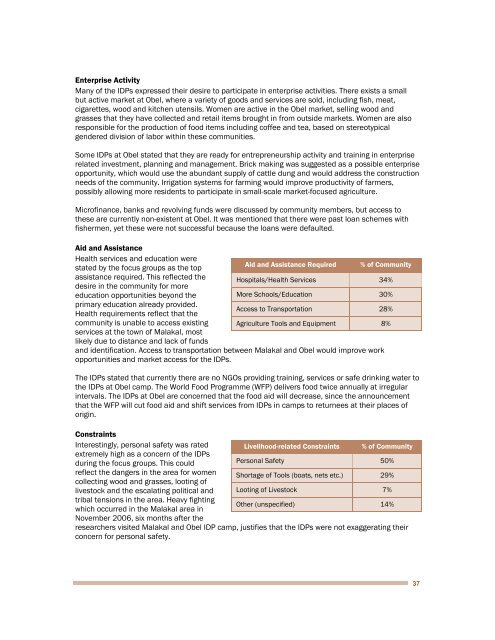
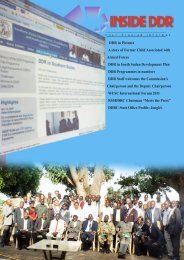
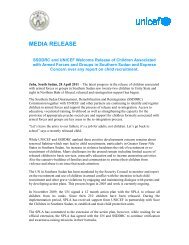
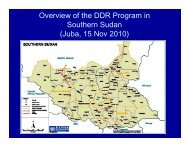
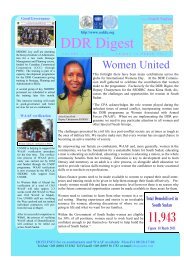
![Download here [975KB] - Republic of South Sudan DDR Commission](https://img.yumpu.com/10592740/1/184x260/download-here-975kb-republic-of-south-sudan-ddr-commission.jpg?quality=85)
